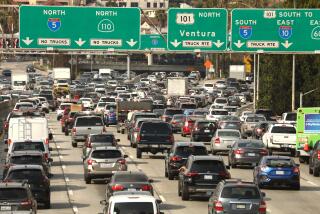Seat Belts Count, in Dollars and Sense
- Share via
California’s 1985 legislative session was only a few hours old when Assembly Speaker Willie Brown introduced a bill requiring the use of seat belts. Other elected officials in the state have made similar proposals.
The seat-belt debate will be lively, particularly in the most populous states, because the federal regulation requiring auto makers to install air bags will be rescinded if states comprising two-thirds of the nation’s population pass seat-belt laws before 1989. California, with 10% of the nation’s population, will be a popular lobbying target for auto makers, who have fought the air-bag rule, and insurance companies and others who see seat belts as the immediate answer to cutting highway deaths and injuries. However, if the goal of our nation’s highway safety programs is to achieve the maximum reduction in death and injuries, we should mandate both seat-belt use and air-bag installation.
Most of us recoil at laws that intrude on our personal lives. So what is the public interest in a matter that may seem to be one of only personal risk? What business is it of government to tell us how to protect ourselves? Both private and government data project millions of taxpayer and consumer dollars saved if seat-belt use increases. Employers could reduce health-care and workers’-compensation costs by insisting that employees use seat belts when driving on company time, and by encouraging their use on personal time. Most important, we won’t lose the companionship and productivity of people who are here today because they buckled up.
New York, New Jersey and Illinois have enacted laws to require drivers to wear seat belts. Education programs alone don’t work. After years of street signs and public-service announcements telling us to buckle up, six out of seven drivers still don’t. People might get the message and be more inclined to convey it to their passengers when “it’s the law!”
These laws serve a purpose similar to littering laws, in that they are intended to change people’s behavior by appealing to their common sense and common interest.
The National Highway Traffic Safety Administration found that the government spends about $3.5 billion a year to provide auto accident victims with benefits such as Medicaid, social-service programs and compensation for lost wages.
The cost to society is even higher. The same 1983 study estimates that it costs us an average of $268,727 per accident fatality for medical care, productivity losses, legal and court costs, coroner/medical examiner costs, emergency services, insurance expenses, public assistance administration and government traffic safety programs.
In human terms, 2,900 motor-vehicle occupants were killed and 240,000 injured on California highways in 1983. The National Highway Traffic Safety Administration has concluded that seat belts are about 57% effective. So, if all Californians had worn seat belts that year, 1,653 lives might have been saved and there might have been 136,800 fewer injuries.
No, seat-belt laws probably cannot be enforced totally. No reasonable proponent of seat-belt laws advocates any unnecessary drain on law-enforcement resources to force people to wear their seat belts. California’s law could include a provision that citations would be issued only if the motorist is stopped for another offense and found to be in violation of the seat belt law.
The experience of Great Britain and Canada shows that the adoption of seat-belt laws, combined with aggressive public education efforts, can achieve voluntary compliance. Seat-belt use doubled in Canadian provinces where it is mandated by law. Before Great Britain’s law went into effect in 1983, 40% of motorists used seat belts; now 95% buckle up.
Companies and labor organizations that are serious about lowering health-care costs already know how auto-related injuries affect their employees’ productivity, and what the cost are in dollar terms.
The National Highway Traffic Safety Administration estimates that the cost to employers for an employee killed in an accident is $120,000 in direct benefits such as wages, medical bills, survivor benefits and property damage. Indirect costs, such as loss of productivity, could be 10 times as great.
Those covered by group health plans should note that health insurance companies spend about $3 billion annually on victims of auto accidents. Those paying automobile insurance premiums pick up an annual tab of more than $9 billion. The cost of insuring drivers ultimately affects future insurance rates.
That is why it’s the government’s business to tell us how to protect ourselves. But more important than the financial savings are the many lives that will be saved, and injuries prevented, if we use all reasonable means--including passing a law--to convince people to buckle up.
More to Read
Get the L.A. Times Politics newsletter
Deeply reported insights into legislation, politics and policy from Sacramento, Washington and beyond. In your inbox twice per week.
You may occasionally receive promotional content from the Los Angeles Times.










